For health and fun and flavour homegrown strawberries rock!
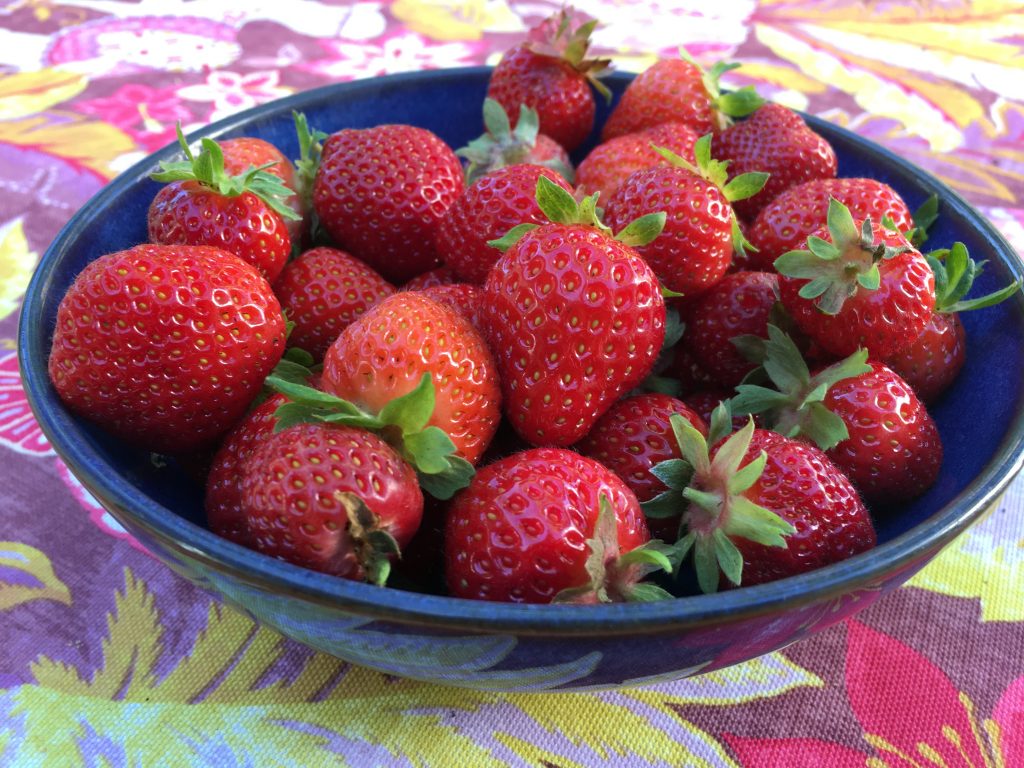
The best flavour in the world is from fresh strawberries but can we seriously trust the commercially grown berries? If in doubt start growing and serving your own fresh strawberries this season. Photo Credit: Donna Balzer
Okay shock factor behind us, what can we do? Have you seen those little packages of dried out strawberry plants sold at your local garden centre or hardware store? These dormant plants are easy to plant and grow and you can start right away.
Last week I made a strawberry planting video with 7-year old twins Rupert and Nathaniel. Yes it’s true. Racing up and down the road on bikes or watching an action video on Netflix probably scores higher in excitement but it was spring break and the twins were visiting. So we planted strawberries. Over 100 pots. Check it out and see the basics of planting these dormant roots. Putting them into 4 ich (9 cm) pots right away means the roots need to be trimmed to fit the pot. It also means you can grow them on until the weather is settled for outdoor planting.
Make sure to plant so the top of the plant where the roots meet the leaves (the crown ) at the top of the pot so there is no sitting water killing roots. Finally, water well. Keep pots in a greenhouse or under grow lights and you’ll get leaves in a week and blooms in two weeks.
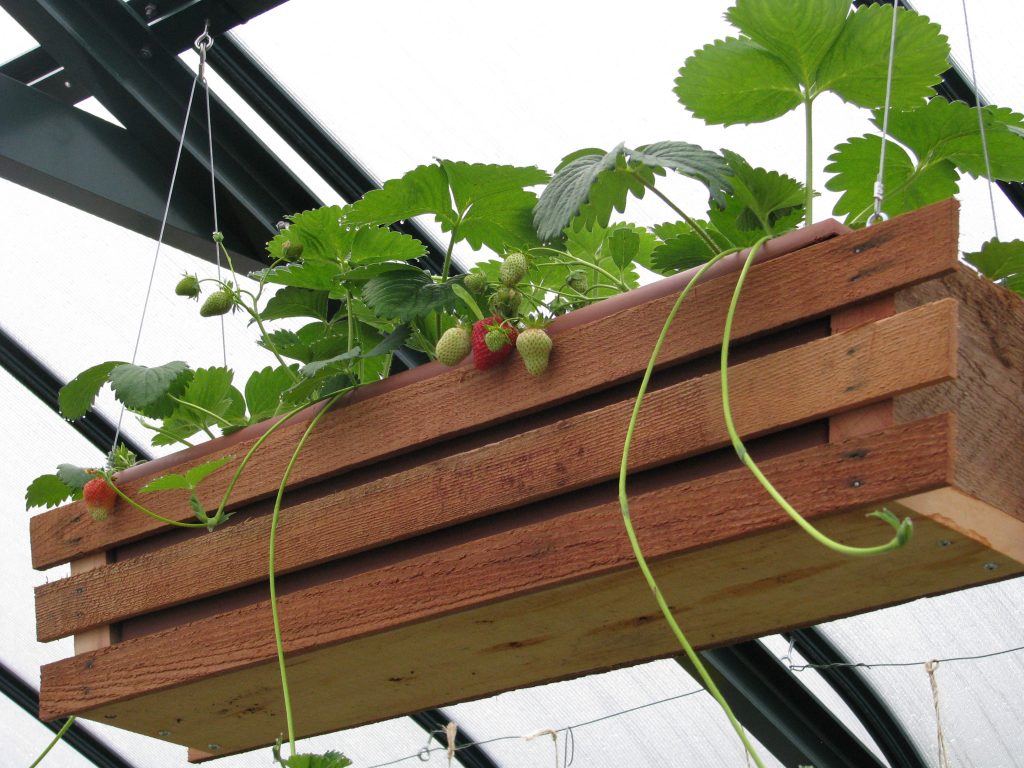
Using hanging baskets lets you grow berries above the other plants in your greenhouse or garden.
What Should You Grow?
There are two basic kinds of strawberries for sale. The ones for really short summers bloom only in June and then focus on building leaves for the rest of the summer. These are known as the June-bearing berries. You pick them early but then they are done for the year. Examples of varieties that are June bearing include Kent, Cavendish, All Star and Totem.
Day neutral or ever-bearing types of berries start blooming soon and will bear fruit right away this year – in June and they will keep right on blooming all summer into fall. I was even surprised by a few berries last November. Day Neutrals bear fruit for a long time but the heaviest crop is still in late June with fewer berries after that. New for me this year are Eversweet (zone 5) and Hecker (best for zone 3). Existing in my garden are Tri-Star (listed zone 5 but I got mine from Dean in Saskatchewan so go figure), and an unknown french variety I purchased from a farmer in Saskatchewan. Yummy. Commercially you can also find Fort Laramie (zone 3) and Albion (zone 4). There are also white berries called “Natural White Strawberry” but they need a separate pollinator and I haven’t tried them yet (I have some on order and two whites will be shipped with two Sonata for pollination)
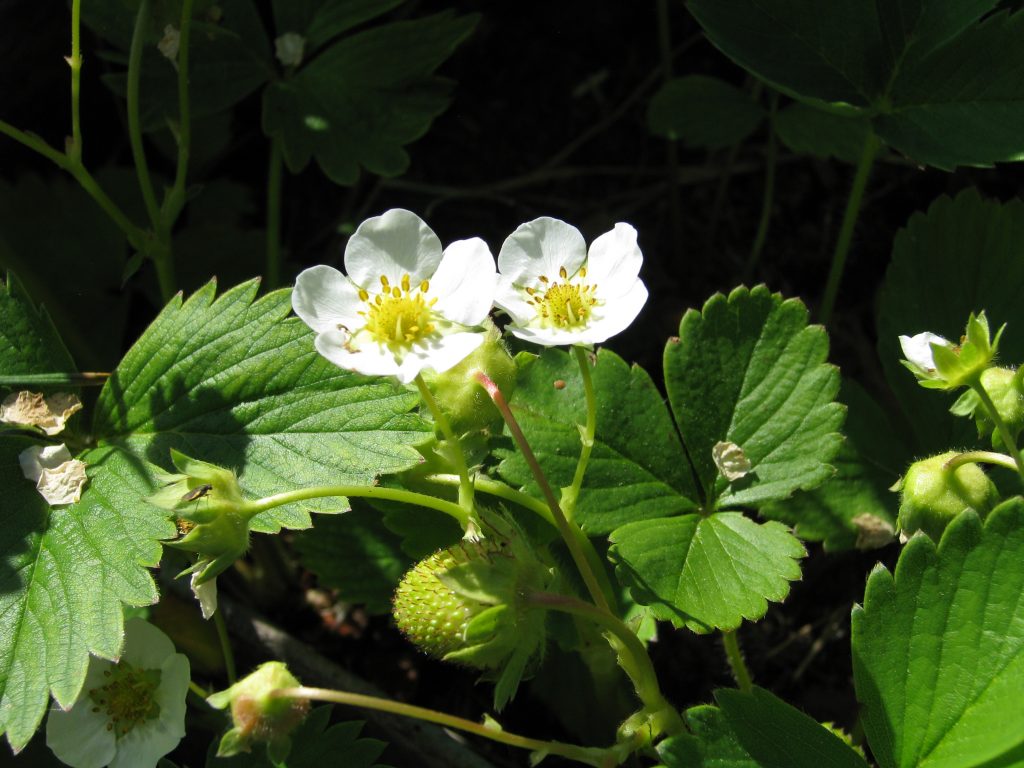
Small plants will start to bloom just a few weeks after potting up the dormant roots. Berries will follow soon after if pollination has happened. If you are not sure flowers are getting pollinated because plants are indoors use a small paint brush to transfer pollen from flower to flower.
What about soil and containers?
As usual I like to pot these guys up early and give them the best soil possible which means lots of air and not overly wet. I add a lot of compost and grow them in
root pouch bags because with this method I can grow them on in flood trays for easy watering and the roots are able to breathe. I got this idea from a Saskatchewan farmer Dean Kreutzer who is over six feet tall and doesn’t want to bend over so far to pick berries.
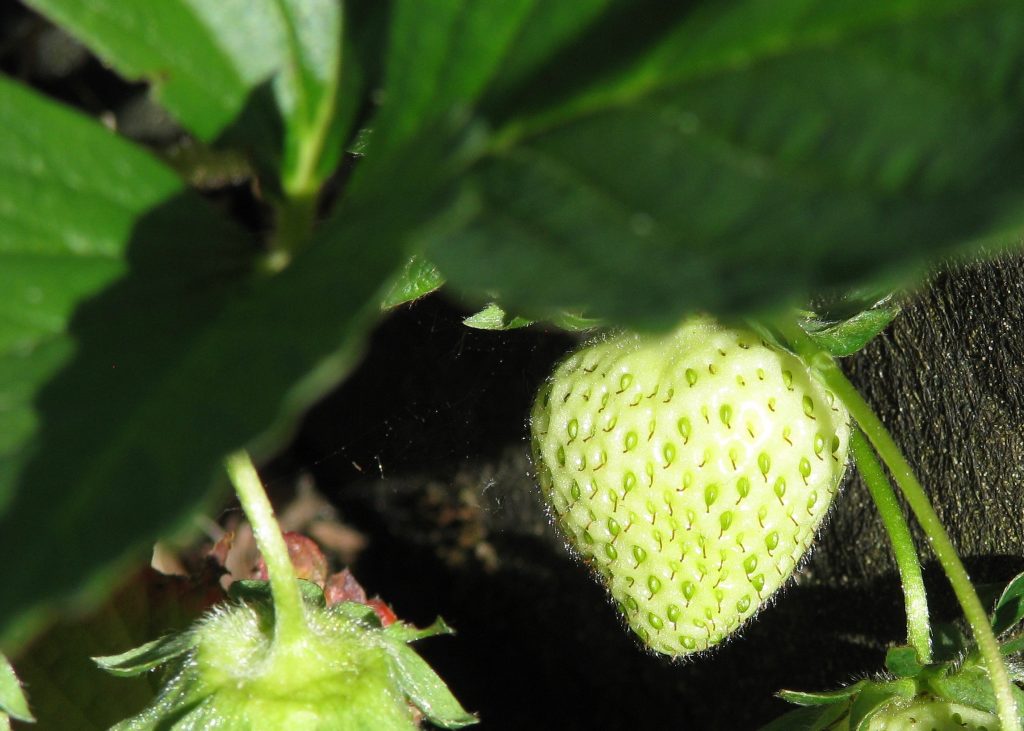
Although white varieties are for sale I have not tried them yet. This white strawberry is immature. In the beginning I picked all my berries too soon because I was used to the pale store-bought fruit.
Care?
Most varieties of strawberries readily sucker with long shoots and this becomes distracting and confusing because main plants and suckers get all tangled up. The suckers usually don’t flower or produce berries in the first year so I try to cut the suckers off early in the season and sometimes in later August I let them fall into little pots where I root them for replanting later. One variety, Tri-Star is basically sucker free so it is simpler to grow but it is almost twice the price of the other Day Neutral strawberries.
Even though I combine my own rich compost with potting media like pro-mix, I also like to add a blend of fertilizer copied from Steve Solomon (The Intelligent Gardener) into the mix before i plant. I do this so that there is plenty of micro-nutrients available to the plants as they grow. Research has shown missing micro-nutrients can lead to disease or insect problems and I don’t want any of that. Let me know if you want a copy of this recipe by emailing me and telling me where you grow.

Flowers with plenty of pollen like the annual alyssum attract beneficial bugs so you will have built in pest control.
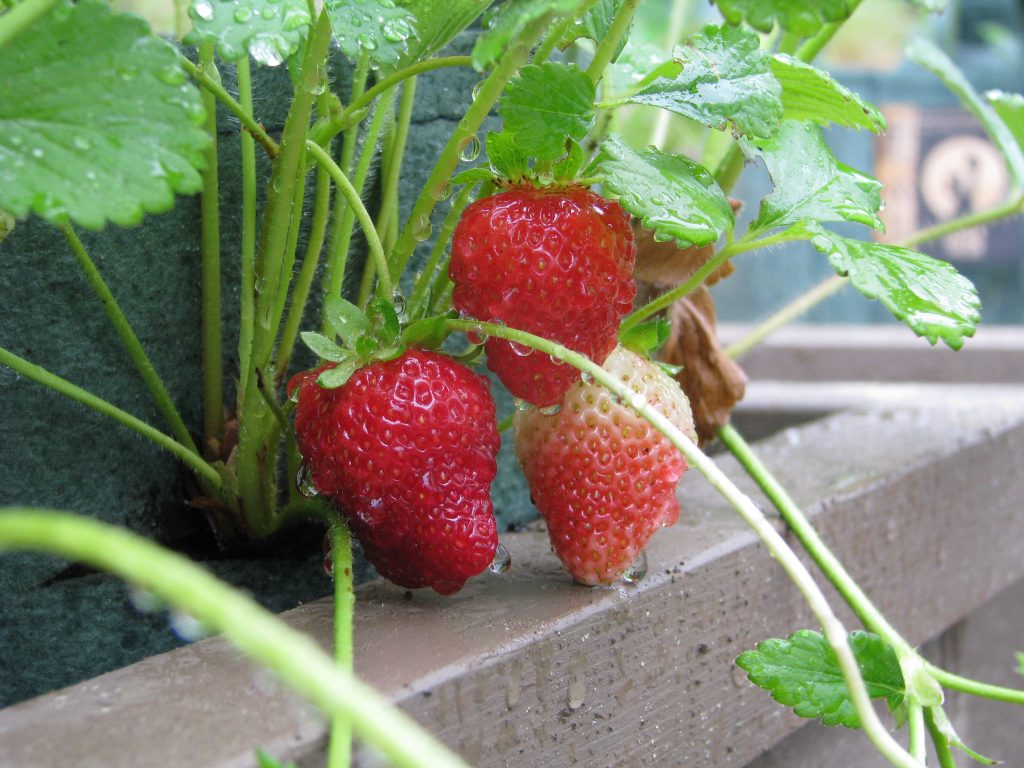
Plants growing in root pouches within flood trays we built for them are super happy. Notice the young suckers coming out of the plants. They will not flower this year but will allow the plant to spread and move. The variety Tri-Star has fewer suckers so is easier to manage but harder to divide later.
Watering needs to keep soils moist but never soggy. This is why some people avoid peat moss – they think it keeps the soil too wet. I make sure to use a coarse mix like Promix HP so they are drier than they would be with other finer potting mixes. As I said I also move the potted plants into root pouches as soon as the weather settles so that they can easily get the water they need but also the drainage they love. The brown root pouches I now use are made from recycled plastic water bottles, are washable and will last for years.
Over Time
Eventually strawberries need dividing. I do this in the earliest part of spring before they grow a lot. I keep the outer plants because they are the youngest and discard the old woody plants because they will not bloom as much.
Strawberries are easy to grow and if you start growing your own you will discover how much flavour they have. Forget about eating commercial berries unless they are locally grown by a farmer you trust. Instead, get on it and plant your own berry crop in your garden or in containers. It is easy enough for the 7-year-old grandkids so I think it is possible for everyone!
For More Info Watch this Short Video:
//www.youtube.com/watch?v=rph0E1xyzgk
PS Do you have questions about Gardening? Join in the conversation on my facebook live event every Monday by clicking right HERE.
Donna Balzer is the Brand Ambassador for BCGreenhouse Builders and she has two greenhouses in her big backyard.

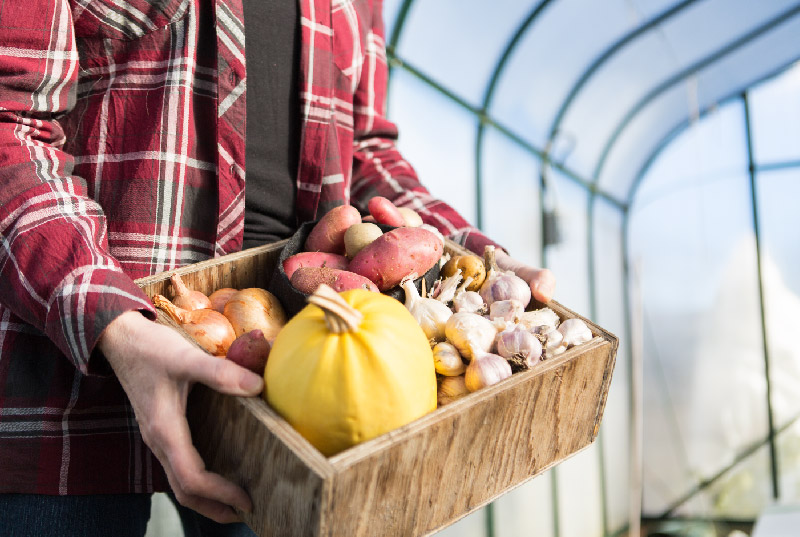





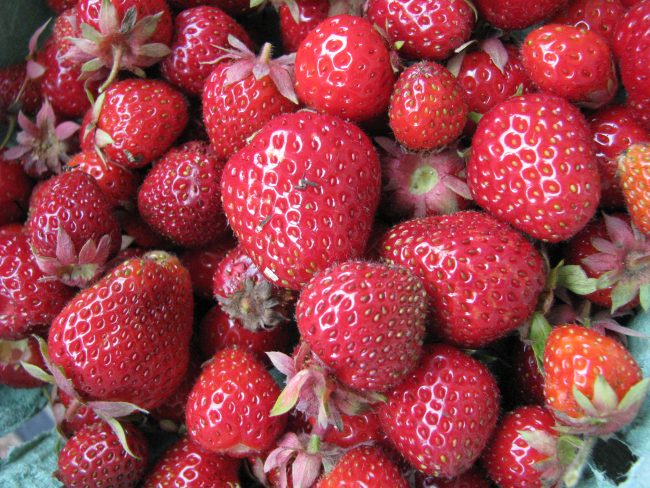























0 Comments